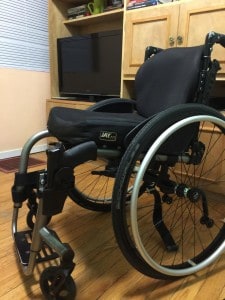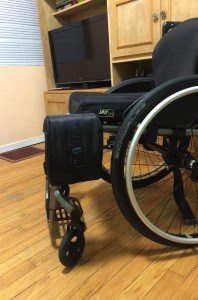Crippled and Carrying: What CCW means to a man living with Cerebral Palsy
I legally carry a firearm. The privilege to carry should be recognized and valued by anyone who practices the right, however, as a disabled person, a man living with Cerebral Palsy, the right to legally carry a gun means so much more to me than it does to most people.
While it is true that it is extremely unlikely the average person will be the victim of a crime, that statistic goes up considerably when limited to persons with disabilities. According to the U.S. Department of Justice, “the age-adjusted rate of nonfatal violent victimization — rape, sexual assault, robbery, aggravated assault and simple assault — was 36 per 1,000 for people with disabilities in 2013, twice the rate for people without disabilities” (source: U.S. News & World Report). I can personally attest to this fact being a reality. At now almost 35 years of age, through absolutely no fault of my own, I have twice survived an aggravated assault and nearly been the victim of a home invasion.
So, why do I carry a gun? First and foremost for protection – of myself, my family and loved ones and those around me; I carry a gun, not because I expect anything to happen or that I am afraid something will happen – I carry a gun because I recognize the fact that things can and do happen – and that is not a risk I am willing to take – especially when it comes to the people I love. I carry by default. Unless I am going somewhere where firearms are prohibited, I’m [responsibly] consuming alcohol or someone specifically tells me not to carry to their residence, I carry. Even in my own home. I home-carry for the simple reason that, in an emergency there is no time to get to a safe – especially if you’re disabled.
As someone who is disabled, being able to carry concealed provides me peace of mind. There is no denying that in some ways my physical abilities in the way of self-defense are limited. Thus, a firearm for me is a force equalizer, just as it is for anyone else. It provides reassurance that I am capable of defending others and myself if need be. I am not a defenseless cripple waiting to be a victim and at the mercy of an assailant.
In this particular case though, being disabled [also] works to my advantage – and it could work to yours just the same. Disability provides an advantage because more often than not, society sees the disabled through the prism of what we can’t do rather than what we can do. Disabled people are not expected to have jobs, families, intimate relationships, be self-sufficient, etc, etc. So, the last thing anybody expects is for someone on crutches or in a wheelchair to be carrying a gun. That is a great advantage!
Albeit, because I am disabled and have to take special considerations into account, effective training is particularly vital; basic pistol courses, holster courses, I.D.P.A. (International Defense Pistol Association) matches – I utilize all of these resources to make sure I am as competent and confident as possible with the tools I use as an armed citizen. I.D.P.A. is especially vital because it simulates real life scenarios. The point here is that whether you are disabled or perfectly healthy, the need for effective training for the purpose of proficiency is universal.
Scrutiny applies to me as a person with a disability just as it applies to anyone else – as it should. In fact, because you are disabled, expect your life to be investigated far more if you ever use your pistol in justifiable self-defense. There will be those that will doubt your ability to safely handle a gun; they will question why you even have one. If you are in any way physically disabled, it will also be automatically assumed that you are mentally deficient as well. This in and of itself makes training of paramount importance. It cannot be underscored enough that, with few exceptions, there is no reason you can’t use and carry a firearm, regardless of disability, and you should not allow anyone to convince you otherwise.
In terms of carrying itself, although the presence of a disability does create some problems, it gives way far more to advantages. Because I use crutches and a wheelchair, carrying inside the waistband is anything but ideal for me, as a result, I either carry outside the waistband or in a bellyband holster. This allows me to carry anything from a compact Sig Sauer P229, a 3-inch medium-frame Smith & Wesson revolver, to a full-size Springfield Armory XDM .45. Hip holsters are great for when you’re on your feet most of the day, whereas bellybands are an excellent mode of carry when predominantly sitting. Additionally, if you use a wheelchair, you can carry off-body by having a holster attached to the chair frame itself. Thus, I have found that I did not have to alter my wardrobe at all; I do not dress around my gun. A long enough cover garment is all that’s needed. In as many ways as disability is limiting, it has its advantages – at least when it comes to the element of surprise in self-defense.
So, how has being legally licensed to carry a firearm changed my life? It has given me an added sense of security and peace of mind. It evens the playing field where I am otherwise disadvantaged. It has also however made me realize that my actions are always under far greater scrutiny than anyone who does not carry. Firearm safety is always a top priority, especially when with others and/or out in public and I am responsible for the safety of those with or around me. The decisions I now make no longer affect only me.
By Rafal Rybak
Rafal is a 34-year-old first-generation Polish-American immigrant and living with Cerebral Palsy. He is a long-time Maxon customer, firearms enthusiast, and an accomplished technical writer. He has a Master's Degree in Communication, Media & Theater from Northeastern Illinois University, and is most passionate about areas of identity & difference, and strives to empower people.




